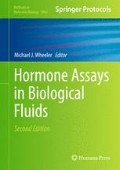Abstract
The growth hormone/insulin-like growth factor (GH/IGF) axis is widely investigated in disorders of growth, development, and anterior pituitary function. Methods are described for three hormones in this axis (growth hormone, IGF-I, and IGF binding protein-3). Enzyme-linked immunosorbent assays (ELISAs) are described as they combine the specificity of antibody–antigen interactions with the sensitivity of simple enzyme assays. Many commercial immunoassays are available for the measurement of GH and IGF-I, and the main problems encountered in the measurement of these clinically important hormones are discussed.
Access this chapter
Tax calculation will be finalised at checkout
Purchases are for personal use only
References
De Palo EF, De Filippis V, Gatti R et al (2006) Growth hormone isoforms and segments/fragments: molecular structure and laboratory measurement. Clin Chim Acta 364:67–76
Godfrey RJ, Madgwick Z, Whyte GP (2003) The exercise-induced growth hormone response in athletes. Sports Med 33:599–613
Martha PM Jr, Rogol AD, Veldhuis JD et al (1989) Alterations in the pulsatile properties of circulating growth hormone concentrations during puberty in boys. J Clin Endocrinol Metab 69:563–570
Rogol AD (2009) Growth hormone and the adolescent athlete: what are the data for its safety and efficacy as an ergogenic agent? Growth Horm IGF Res 19:294–299
Fryburg DA, Gelfand RA, Barrett EJ (1991) Growth hormone acutely stimulates forearm muscle protein synthesis in normal humans. Am J Physiol 260:E499–E504
Hansen TK (2002) Pharmacokinetics and acute lipolytic actions of growth hormone. Impact of age, body composition, binding proteins, and other hormones. Growth Horm IGF Res 12:342–358
Hazem A, Elamin MB, Malaga G et al (2011) The accuracy of diagnostic tests for GH deficiency in adults: a systematic review and meta-analysis. Eur J Endocrinol 165:841–849
Blundell TL, Bedarkar S, Rinderknecht E et al (1978) Insulin-like growth factor: a model for tertiary structure accounting for immunoreactivity and receptor binding. Proc Natl Acad Sci USA 75:180–184
Rinderknecht E, Humbel RE (1978) The amino acid sequence of human insulin-like growth factor I and its structural homology with proinsulin. J Biol Chem 253:2769–2776
Wurzburger MI, Sonksen PH (1996) Natural course of growth hormone hypersecretion in insulin-dependent diabetes mellitus. Med Hypotheses 46:145–149
Daughaday WH, Hall K, Raben MS et al (1972) Somatomedin: proposed designation for sulphation factor. Nature 235:107
Sonksen PH (2001) Insulin, growth hormone and sport. J Endocrinol 170:13–25
Le Roith D, Bondy C, Yakar S et al (2001) The somatomedin hypothesis: 2001. Endocr Rev 22:53–74
Jones JI, Clemmons DR (1995) Insulin-like growth factors and their binding proteins: biological actions. Endocr Rev 16:3–34
Rosenfeld RG, Hwa V, Wilson L et al (1999) The insulin-like growth factor binding protein superfamily: new perspectives. Pediatrics 104:1018–1021
Guler HP, Zapf J, Schmid C et al (1989) Insulin-like growth factors I and II in healthy man. Estimations of half-lives and production rates. Acta Endocrinol (Copenh) 121:753–758
Wallace JD, Cuneo RC, Baxter R et al (1999) Responses of the growth hormone (GH) and insulin-like growth factor axis to exercise, GH administration, and GH withdrawal in trained adult males: a potential test for GH abuse in sport. J Clin Endocrinol Metab 84:3591–3601
Evans AJ (1995) Screening tests for growth hormone deficiency. J R Soc Med 88:161P–165P
Daughaday WH, Ward AP, Goldberg AC et al (1982) Characterization of somatomedin binding in human serum by ultracentrifugation and gel filtration. J Clin Endocrinol Metab 55:916–921
Daughaday WH, Parker KA, Borowsky S et al (1982) Measurement of somatomedin-related peptides in fetal, neonatal, and maternal rat serum by insulin-like growth factor (IGF) I radioimmunoassay, IGF-II radioreceptor assay (RRA), and multiplication-stimulating activity RRA after acid-ethanol extraction. Endocrinology 110:575–581
Mesiano S, Young IR, Browne CA et al (1988) Failure of acid-ethanol treatment to prevent interference by binding proteins in radioligand assays for the insulin-like growth factors. J Endocrinol 119:453–460
Clemmons DR (2007) IGF-I assays: current assay methodologies and their limitations. Pituitary 10:121–128
Blum WF, Breier BH (1994) Radioimmunoas-says for IGFs and IGFBPs. Growth Regul 4(Suppl 1):11–19
Khosravi MJ, Diamandi A, Mistry J et al (1996) Noncompetitive ELISA for human serum insulin-like growth factor-I. Clin Chem 42:1147–1154
Quarmby V, Quan C, Ling V et al (1998) How much insulin-like growth factor I (IGF-I) circulates? Impact of standardization on IGF-I assay accuracy. J Clin Endocrinol Metab 83:1211–1216
Krebs A, Wallaschofski H, Spilcke-Liss E et al (2008) Five commercially available insulin-like growth factor I (IGF-I) assays in comparison to the former Nichols advantage IGF-I in a growth hormone treated population. Clin Chem Lab Med 46:1776–1783
Frystyk J, Freda P, Clemmons DR (2010) The current status of IGF-I assays–a 2009 update. Growth Horm IGF Res 20:8–18
Burns C, Rigsby P, Moore M et al (2009) The first international standard for insulin-like growth factor-1 (IGF-1) for immunoassay: preparation and calibration in an international collaborative study. Growth Horm IGF Res 19:457–462
Clemmons DR (2011) Consensus statement on the standardization and evaluation of growth hormone and insulin-like growth factor assays. Clin Chem 57:555–559
Baumann G (1991) Growth hormone heterogeneity: genes, isohormones, variants, and binding proteins. Endocr Rev 12:424–449
Ebdrup L, Fisker S, Sorensen HH et al (1999) Variety in growth hormone determinations due to use of different immunoassays and to the interference of growth hormone-binding protein. Horm Res 51(Suppl 1):20–26
Carrozza C, Lapolla R, Canu G et al (2011) Human growth hormone (GH) immunoassay: standardization and clinical implications. Clin Chem Lab Med 49:851–853
Bidlingmaier M (2008) Problems with GH assays and strategies toward standardization. Eur J Endocrinol 159(Suppl 1):S41–S44
Trainer PJ, Barth J, Sturgeon C et al (2006) Consensus statement on the standardisation of GH assays. Eur J Endocrinol 155:1–2
Author information
Authors and Affiliations
Editor information
Editors and Affiliations
Rights and permissions
Copyright information
© 2013 Springer Science+Business Media New York
About this protocol
Cite this protocol
Guha, N. (2013). Assays for GH, IGF-I, and IGF Binding Protein-3. In: Wheeler, M. (eds) Hormone Assays in Biological Fluids. Methods in Molecular Biology, vol 1065. Humana Press, Totowa, NJ. https://doi.org/10.1007/978-1-62703-616-0_7
Download citation
DOI: https://doi.org/10.1007/978-1-62703-616-0_7
Published:
Publisher Name: Humana Press, Totowa, NJ
Print ISBN: 978-1-62703-615-3
Online ISBN: 978-1-62703-616-0
eBook Packages: Springer Protocols

